For the more popular Watanabe artists like Hasui and Shinsui, the knowledge of which prints
came before the earthquake and which after, is well documented.
Most of their prints are margin dated and, with very few exceptions, there were no attempts to
reproduce their old prints.
They went forward with new designs.
With Shôtei, it is considerably more difficult for a collector to determine whether
the print that he is looking at was produced prior to or after the earthquake.
Most of Shôtei's prints are not dated.
Additionally, many of them were reproduced, from new blocks carved after the disaster.
As we find more and more of the pre-/post- sets, the question is raised, "How can we tell which is which?"
That's the purpose of this page: to explore some methods we might use to sort them out.
I've been warned by another collector who is older, wiser, and considerably more experienced than myself
that, "Identifying any particular print as before or after 1923 is fraught with problems."
But I just can't help myself...
The label at the left, with the "No. 11 Gorobei-cho" address, is from the 1920 oban Shôtei print
"Tokumochi" (O-29 in the catalog).
After the 1923 quake, Watanabe's shop was rebuilt at 9, Nishi 8-chome, Ginza.
I'm operating under the assumption that any print which has a label on the reverse side with the
Gorobei-cho address is a pre-earthquake print.
There are a limited number of small black/white images of Shôtei prints in the 1936 Watanabe
catalog.
I have access to a second-generation photocopy which makes the images a bit distorted.
If I can see clearly enough to recognize one of members of a pre-/post-earthquake set in the catalog,
I feel comfortable assuming it is the post-earthquake version.
On the Variant Shôtei Print Designs
page, the 2 versions of "Spring Evening" (M-12) are sorted out using this method.
The highest cartouche number that I've seen is the one at the far left, from print M-72, which reads "46".
Since Shôtei designed some 500 prints for Watanabe before the quake, I'm working under the assumption
that a print containing one of these cartouches can be dated as from 1910 or prior.
If I see some higher numbers, I might modify this assumption.
Watanabe's inventory number stamps
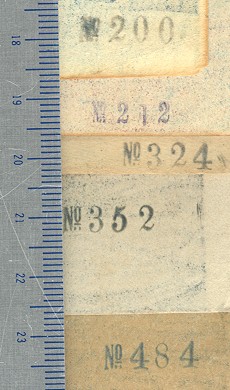
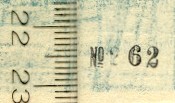




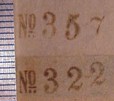

Both before and after the earthquake, Watanabe stamped some of their prints with catalog numbers in the
lower right corner of the back side.
After the quake, since everything had been destroyed, Watanabe started with new catalog numbers, re-using numbers
which had been previously used for different prints.
This strategy dictates that if the inventory number found on a print is also found in the 1936 Watanabe
catalog, but with a title and/or artist attribution describing a different print, then the print that you are
looking at must be a pre-earthquake print.
Let's discuss each of the prints whose stamped inventory numbers are shown above.
No. 190 is the number stamped on the back of Shôtei print
P-7.
The Watanabe 1936 catalog uses number 190 to refer to another Shôtei print: C-4,
"Moon-rise on Minatomachi; girls on bridge".
Verdict: P-7 is pre-earthquake.
No. 200 is the number stamped on the back of Kakei print
K-2.
I looked up catalog number 200 in the Watanabe post-quake
catalog and found that it refers to a print titled "Kiribitake in pouring rain" by Hiroshige II.
Verdict: pre-earthquake.
No. 212 is on the Shôtei print
M-12 or Spring Evening.
The Watanabe catalog lists 212 as the Shôtei print "Willow tree and lady with lantern in spring evening",
and shows a thumbnail black and white picture of the same print.
Verdict: post-earthquake.
No. 262 is on the Kakei print
K-1.
In Watanabe's post-quake numbering system, print 262 is called "Puppet Manipulators" by Kiyohiro.
Verdict: pre-earthquake.
No. 322 is on Kakei print
K-11.
Print 322, in the 1936 catalog, is Hiroshige's "Traveller's bonfire at Karuizawa".
Verdict: pre-earthquake.
No. 324 is on the backside of Kakei print
K-4.
Print 324, in the 1936 catalog, is Hiroshige's "Morning mist at Mishima (Tokaido)".
Verdict: pre-earthquake.
No. 352 is the number stamped on the back of Kakei print
K-6.
Post-quake, that number refers to a Hiroshige fan print titled "Zojoji Temple from Takeshiba Bay".
Verdict: pre-earthquake.
No. 353 is the number stamped on the back of Shôtei print
M-112.
Post-quake, that number refers to a Hiroshige fan print titled "Mt. Fuji from Hommoku Bay".
Verdict: pre-earthquake.
No. 357 is the on the back of Shôtei print
M-123.
Post-quake, that number refers to the Gogaku print "Shower at Tempôzan, Ôsaka".
Verdict: pre-earthquake.
No. 484 is on the Shôtei print
M-90 or North Kasuminoura.
The 1936 catalog has print number 484, but it is by Ohara Shôson and titled "Fireflies flying; some on grass".
Verdict: pre-earthquake.
No. 547 is on the creped Shôtei print
S-44.
The 1936 catalog has print number 547, but it is a mitsugiri-ban print, "Peony flower and butterfly"
by Ohara Shôson.
Verdict: pre-earthquake.
No. 759 is on the Shôtei print
C-33.
The 1936 catalog has print number 759 as a small-format Hiroshige reproduction.
Verdict: pre-earthquake.
No. 897 is on the Shôtei print
M-15.
The 1936 catalog has print number 897, but it is a Hasui postcard print.
Verdict: pre-earthquake.
Size of the numbers:
The numbers 212 and 262 above, at 3 to 4mm in height, are smaller than the other numbers, which are 4 to 5mm.
There was a series of smaller prints added to the Shôtei catalog as S-24 through S-43, many of which
were tipped to backing paper on which were stamped the Watanabe post-quake inventory numbers, in the 3-4mm size.
I was ready to jump to the conclusion that the smaller format numbers were applied post-quake
while the larger numbers were applied pre-quake.
I need to partially abandon that theory, since 262, stamped in the smaller format, has been shown to be on
a pre-quake print,
However, it might turn out that we will see the larger size numbers stamped exclusively on pre-quake prints.
Please keep your eyes open and let me know what you see.
Registration marks in the image
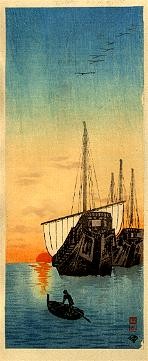
Another surprise from the
1910 Weeks family scrapbook
was the number of prints with pigment missing from the bottom right corner and about 2/3 of the way up the side.
This was a result of printing without margins to save paper.
The carved registration points were concave and unable to be effectively inked and impressed.
It is unusual to see these in Watanabe's later products.
His early lack of respect for "tourist" prints is revealed by this.
While the presence of these marks is not sufficient to call a print pre-earthquake, it seems that it may be
used in conjunction with other evidence to build a case.
Generational Shrinkage
Ukiyo-e collector Paul Steier suggested the following theory in an October, 2002 email:
If you have an original
and a recut print side by side, the image on the recut print should be
slightly smaller than the original.
This is because before the original print was printed, the paper was
moistened and so expands. This is done to prevent the pigments from
spreading into the paper. After being printed, the print dries out
and shrinks.
When a recut is made, normally an original print is traced the make
the new blocks, so the recut image will be smaller. At least, that's
the theory.
Looking at the Shôtei pre-/post-earthquake sets on the
Shôtei variants page,
one can see prints where some of the image has been slavishly copied (as if traced)
and other areas have been redrawn.
The only pair that I own are the 2 versions of M-14, which at first glance look to be completely
different.
But on closer inspection, there are some details which seem to be slavishly copied, specifically
the top line of the crater and the tree directly below the peak. Using a pair of dividers, I can
see that the newer print is slightly smaller when test measuring between multiple common points.
However, I'd love to get my hands on some more examples side-by-side so that I can get some
more datapoints.
Especially interesting would be M-72. The woman and her laundry look traced to me.
Historical Records of Exhibitions
Shin hanga researcher, Tosh Doi, uncovered some catalogs of exhibitions which included some
Shôtei prints.
These catalogs were documented in the book "Kawase Hasui Mokuhangashu" by Muneshige Narazaki.
Catalog prints M-15 and M-117 were listed as having been exhibited during June 16-20, 1921 at
Shirokiya, Tokyo. This information allowed them to be dated as <= 1921.
In April of 1932 there was another exhibit at Shirokiya. It included prints: O-1 through O-10,
along with: M-1, M-14, M-16, M-28, M-30, M-31, M-33, M-62, and M-63. Some of those prints were previously
dated as <= 1936, because they were in the 1936 catalog. Their date has been changed to <= 1932.
Titles and Colors
A point that was made by the author of the
Shôtei biography
from the Folk Museum of Ota City was that some of the post-earthquake versions of the mitsugiri-ban
prints had titles that their predecessors were missing.
Also, the earlier versions tended to have more subdued colors than their post-earthquake replacements.
Round "Watanabe" Seals
Most Hasui collectors work under the assumption that there are 2 varieties of the round
Watanabe seal, the 6mm and the 7mm version.
According to common wisdom, the 7mm round seal indicates a posthumous edition, produced after
Hasui's death in 1957.
This has been repeatedly denied by the current generation of owners of the Watanabe Color
Print Company, who claim that there have been many round seals in various sizes, which have
been randomly applied to prints.
They caution Western collectors against reading too much into the various seal formats.
Is that going to stop me? Not likely...
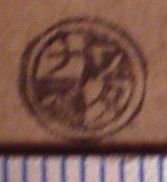
It is very unusual to encounter a round Watanabe seal on a smaller format Shôtei
print (mitsugiri-ban or chuban).
Almost every time that has happened, the seal has been somewhat larger than 6mm and the
print has been identified as being a pre-earthquake early print.
The seal to the right is about 6.5mm. I've seen them as large as 9mm.
Of course, the presence of such a seal is not sufficient, on its own, to make a conclusive
finding, but should be used within the context of other clues.